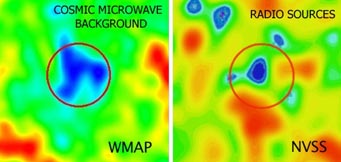We learn early on that space is basically empty at every scale — the distances between planets, between stars, and between galaxies is enormous compared to the objects themselves. If the Sun were a beach ball in Houston, the nearest stars would be "neighboring" beach balls in San Francisco or Boston.

Maps of southeastern Eridanus show the "big nothing" at microwave and radio wavelengths. The circles are 10&176; across.
L. Rudnick & others / NRAO / AUI / NSF / NASA
But now astronomers have taken this "emptiness" to a whole new level. A trio of astronomers at the University of Minnesota have identified an enormous hole in intergalactic space that, they estimate, is nearly a billion light-years across. It appears to be devoid of both normal matter (stars, galaxies, gas) and unseen, unexplained "dark matter." Not only is it the biggest nothing known, but it's also totally unexpected.
The area in question, roughly 6° across, is in the direction of the constellation Eridanus and relatively nearby, cosmologically speaking. Some years ago the WMAP spacecraft had noted a large cold spot there in the cosmic microwave background. Another survey using the big radio dishes of the Very Large Array in New Mexico showed that it contains no galaxies either.
The researchers' findings, due to be published in Astrophysical Journal, can be viewed online. Or you can start with the easier-to-digest press release about this study.
 0
0
Comments
You must be logged in to post a comment.